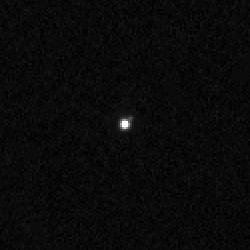Top Qs
Timeline
Chat
Perspective
(532037) 2013 FY27
Scattered disc object From Wikipedia, the free encyclopedia
Remove ads
(532037) 2013 FY27 (provisional designation 2013 FY27) is a large trans-Neptunian object in the scattered disc.[7] It was discovered on 31 March 2014 by Scott Sheppard and Chad Trujillo at Cerro Tololo Observatory in Chile.[1] With a nominal diameter of about 740 km (460 mi), 2013 FY27 is large enough that some astronomers consider it a possible dwarf planet. It is estimated to be the largest unnamed Solar System object with a measured diameter, though uncertainties in the measurements mean that several others could actually be larger. 2013 FY27 has one unnamed moon about 190 kilometres (120 mi) in diameter.
Remove ads
Orbit

2013 FY27 orbits the Sun once every 449 years. It will come to perihelion around November 2202,[2][b] at a distance of about 35.6 AU. It is currently near aphelion, 80 AU from the Sun, and, as a result, it has an apparent magnitude of 22.[1] Its orbit has a significant inclination of 33°.[2] The sednoid 2012 VP113 and the scattered-disc object 2013 FZ27 were discovered by the same survey as 2013 FY27 and were announced within about a week of one another.
Remove ads
Physical properties
2013 FY27 has a diameter of about 740 kilometres (460 mi), placing it at a transition zone between medium-sized and large TNOs. Using the Atacama Large Millimeter Array and Magellan Telescopes, its albedo was found to be 0.17, and its colour to be moderately red. 2013 FY27 has an absolute magnitude (H) of 3.2,[2] making it the ninth-intrinsically-brightest known trans-Neptunian system.[8]
The brightness of 2013 FY27 varies by less than 0.06 mag over hours and days, suggesting that it either has a very long rotation period, an approximately spheroidal shape, or a rotation axis pointing towards Earth.[3]
2013 FY27 is a possible dwarf planet, though not a likely one. Grundy et al. calculate that bodies less than about 1000 km in diameter, with albedos less than ≈0.2 and densities less than ≈1.2 g/cm3, may retain a degree of porosity in their physical structure, having never collapsed into fully solid bodies, and therefore could not be dwarf planets.[9] However, the albedo of 2013 FY27 may be around that limit, and there is no way to estimate its density.
Remove ads
Satellite
Summarize
Perspective
Using Hubble Space Telescope observations taken in January 2018, Scott Sheppard found a satellite around 2013 FY27, that was 0.17 arcseconds away and 3.0±0.2 mag fainter than its primary. The discovery was announced on 10 August 2018.[11] The satellite does not have a provisional designation nor a proper name.[2] Assuming the two components have equal albedos, they are about 742+78
−83 km and 186±20 km in diameter, respectively.[3] Follow-up observations were taken between May and July 2018 in order to determine the orbit of the satellite,[4] but the results of these observations remain yet to be published as of 2022[update].[6] Once the orbit is known, the mass of the system can be determined.
See also
Notes
- The uncertainty in the time of perihelion passage is ≈1 month (1-sigma) or 3.6 months (3-sigma).[2]
References
External links
Wikiwand - on
Seamless Wikipedia browsing. On steroids.
Remove ads


